#bessatsu shonen magazine
Text
EMA

#snk#snk official art#mikasa ackerman#eren yeager#armin arlert#eremika#eremin#arumika#ema#shiganshina trio#aot#attack on titan#shingeki no kyojin#bessatsu shonen#bessatsu shonen magazine#mappa studio#snk s4#aot s4#snk final season#aot final season#attack on titan final season#shingeki no kyojin final season#snk ending#aot ending#snk anime#aot anime#isayama hajime#hajime isayama#snk fly
311 notes
·
View notes
Text




My favourite Nagi covers from BSM so far!!
He looks so ✨✨✨🔥🔥🔥🌟🌟🌟🤍🤍🤍
#nagi seishiro#blue lock#episode nagi#magazine cover#bessatsu shonen magazine#anime charcters are such celebrities fr
40 notes
·
View notes
Text
If you hadn't heard, Tatsuki Fujimoto (author of Chainsaw Man, Fire Punch, Goodbye Eri, etc) got banned off Twitter for impersonating his imaginary little sister (long story).
After, setting up a new Twitter account, he sends out a bunch of tweets in an attempt to verify his identity as Tatsuki Fujimoto.
This one is the most fascinating to me.

If you didn't know 「おかえりアリス」 / Okaeri Alice / Welcome Back, Alice is a pyschological manga by Shūzō Oshimi - the same mangaka as Blood on the Tracks, Inside Mari, and The Flowers of Evil.
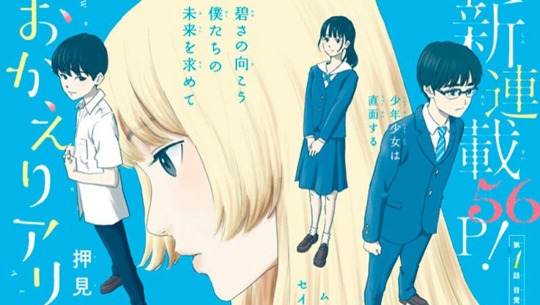
While Okaeri Alice might have a lot of funny moments and is primarily advertised as a "sex comedy", it is an incredibly fucked-up manga that explores gender, puberty, and identity.
The basic plot is that this boy named Yohei has a crush on his childhood friend named Mitani. However, Yohei's love is unrequited because Mitani has a crush on Yohei's male childhood friend Kei. Kei moves away during middle school, while Mitani and Yohei have ceased communication all together.

Shit gets real when they all reunite in high school. Kei comes back dressed looking like a woman - claiming to have given up manhood (while not wanting to be a woman). It is also discovered that Kei had a crush on Yohei - completing the love triangle.

The rest of manga is spent having Yohei getting sexually harassed by both of his childhood friends.
Kei's doing it because they like Yohei. Mitani's doing it to get back at Kei. And all the while, Yohei is suffering at the hands of his confusing male puberty.
If you know anything about Tatsuki Fujimoto, you know he loves getting dominated by girls - so this manga is right up his alley 🎳. Fujimoto is also no stranger to exploring gender in his own manga (for example, he wrote a trans male character in Fire Punch).
So yeah, this is the funniest manga this year- according to Tatsuki Fujimoto. I think this is a pretty good clue indicating that this is indeed Fujimoto's real twitter account.
So when are we getting an anime adaptation of Okaeri Alice
#tatsuki fujimoto#fujimoto tatsuki#chainsaw man#チェンソーマン#okaeri alice#おかえりアリス#okaeri arisu#welcome back alice#shuzo oshimi#shūzō oshimi#manga#twitter#漫画#Bessatsu Shōnen Magazine#bessatsu shonen magazine#kodansha#fire punch#goodbye eri#wikipedia#藤本 タツキ#押見 修造#Oshimi Shūzō#tweet#japanese
121 notes
·
View notes
Text

art by A2T
#Kodansha#Bessatsu Shonen Magazine#Attack on Titan#retro#vintage#BLEACH#DBZ#Dragon Ball Z#Naruto#World of Warriors#One Piece#Chainsaw Man#Jojo's Bizarre Adventure#Jujutsu Kaisen
7 notes
·
View notes
Text

Arslan and Azrael will feature on the cover of the January 2023 edition of Bessatsu Shounen Magazin.
Release date: 9th December 2022
#the heroic legend of arslan#Arslan Senki#hiromu arakawa#Arslan#Azrael#bessatsu shonen magazine#magazine
63 notes
·
View notes
Text

#attack on titan#shingeki no kyojin#hajime isayama#2009#2000s#2010s#2020s#seinen#bessatsu shonen magazine#complete
7 notes
·
View notes
Text
Wistoria: Wand and Sword Anime Revealed For July 2024
Wistoria: Wand and Sword Anime Revealed For July 2024
#杖と剣のウィストリア #anime #Wistoria #manga
Kodansha announced the latest manga series written by the creator of Is It Wrong To Pick Up Girls In A Dungeon‘s Fujino Ōmori and illustrated by Toshi Aoi will be getting an anime adaption and it is set to premiere in Japan in July!
Image Credit: Fujino Omori, Toshi Aoi/Kodansha
In addition to this announcement, the cast and staff details were revealed. Kohei Amasaki (My Hero Academia, High…

View On WordPress
#Action#Animation#Anime#Bessatsu Shonen Magazine#Books#Entertainment#Fantasy#Fujino Omori#Is it wrong to pick up a girl in a dungeon?#Kodansha#Manga#Shonen Manga#Toshi Aoi#Wistoria Wand and Sword#杖と剣のウィストリア
0 notes
Text
Happiness nº 08

No início do volume, Sudô encontra Yukiko mantida em cativeiro para ser entregue como sacrifício para Yuuki, um vampiro que era seu amigo antes da transformação. Em uma tentativa desesperada de salva-la, Sudô parte com tudo, em uma investida contra Sagurane, o Guru líder da seita que acredita que Yuuki é uma espécie de Deus e acaba gravemente ferido.
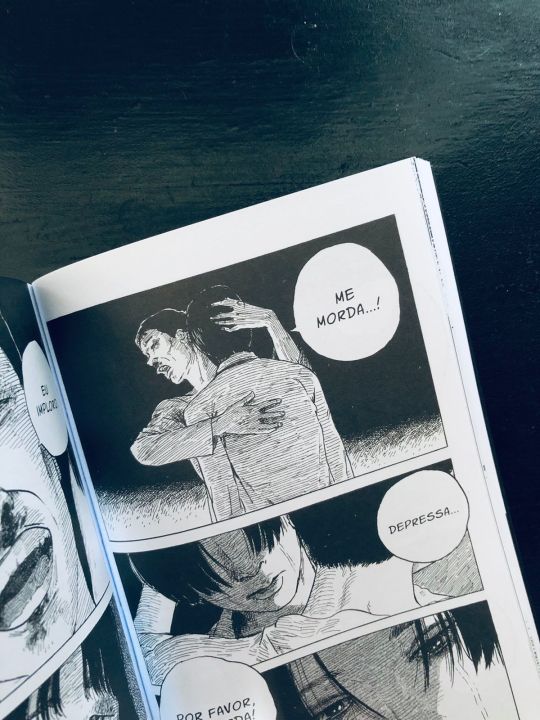
É mostrado também um pouco do passado de Sagurane, tentando de certa forma justificar o comportamento que o mesmo apresenta ao longo de toda a história, até mesmo tentando humaniza-lo, devido a maneira com que a sua família o tratava (tratamento este decorrente das ações questionáveis de Sagurane).


A edição em questão é a de formato físico, publicada originalmente em Março de 2020 pela editora NewPop com 192 páginas preto e branco, reunindo os capítulos de: Happiness 36-40.
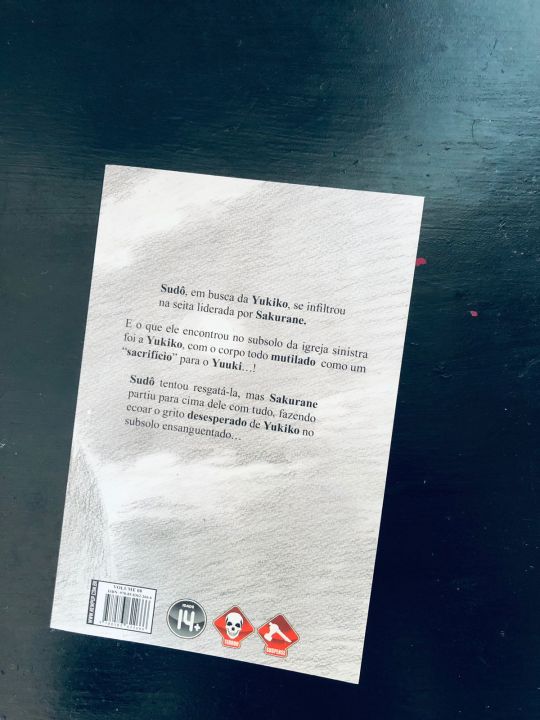
1 note
·
View note
Text
Bessatsu Shonen Magazine Cover !!!

81 notes
·
View notes
Text
Shoujo Manga's Golden Decade (Part 2)
Shoujo manga, comics for girls, played a pivotal role in shaping Japanese girls’ culture, and its dynamic evolution mirrors the prevailing trends and aspirations of the era. For many, this genre peaked in the 1970s. But why?
Part 1
The Year of 24 Group
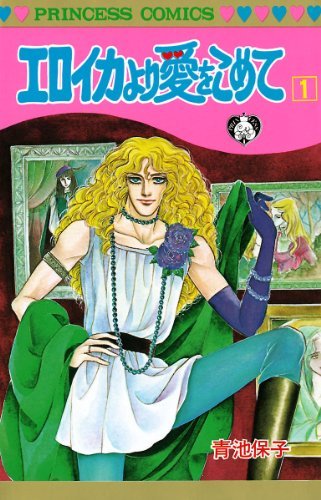
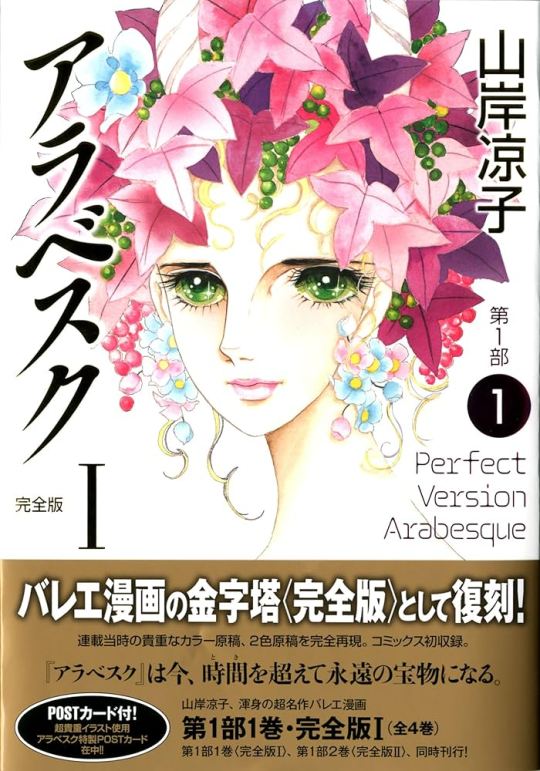
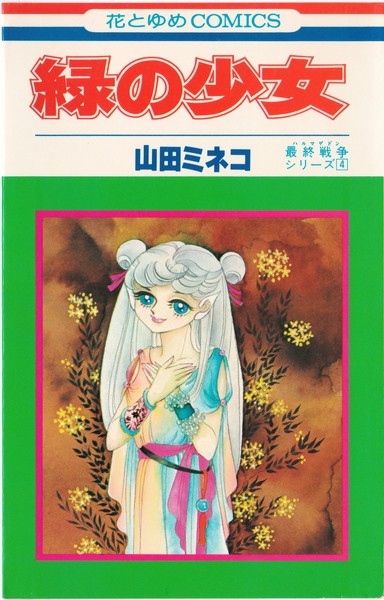

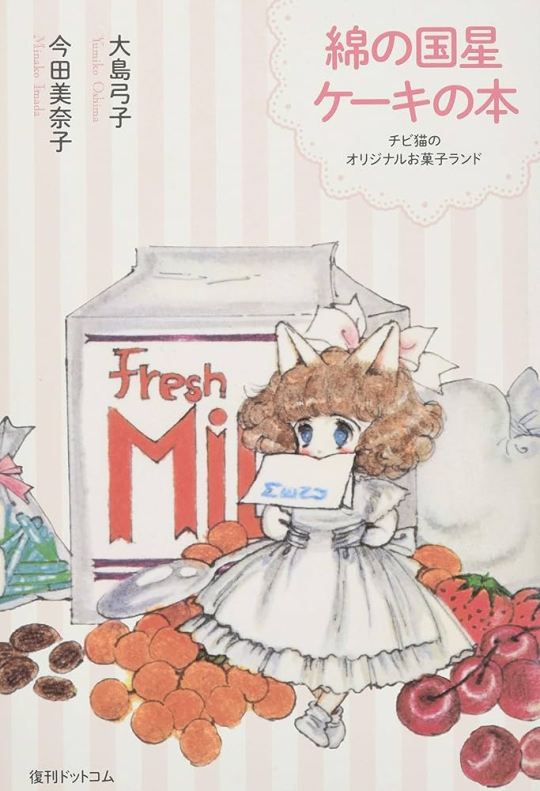

Some of the best-selling work by the Year 24 Artists (l-to-r): Yasuko Aoike's "From Eroica with Love," Ryoko Yamagishi's "Arabesque," Mineko Yamada's "Minori no Shoujo," Toshie Kihara's "Yomie no Ishibume," Yumiko Oshima's "The Star of Cottonland," Yuuko Kishi's "Tamasaburo."
Back in the early '70s, there was the prevailing notion that manga was for young kids. Despite the variety in themes, big magazines like Margaret, Shoujo Club, Nakayoshi, and Ribon were theoretically aimed at elementary school-aged girls.
In practice, the reality was more nuanced. Due to being published in Weekly Margaret, "The Rose of Versailles" was for kids. And it did very well with them. Yet, its revolutionary romance also appealed to broader audiences, exemplifying the crossover potential of shoujo manga. It was the title that opened the door for what is known as "the golden age of shoujo," which was further cemented by several other groundbreaking hits.
These hits widened the shoujo manga field, and soon, other editorial houses also wanted to cash in. Shogakukan, which published the powerful Weekly Shonen Sunday, entered the shoujo market in the late '60s. Shueisha and Shogakukan also partnered to form a keiretsu and open the Hakusensha publisher which deals mostly with shoujo manga.
That is the context in which a batch of artists known as "The Magnificent 24 Group" rose. And they were another key reason as to why '70s shoujo made such a mark. These manga-kas introduced themes such as sci-fi and homosexuality to the segment, revolutionized its art, further explored historical and terror narratives, and generally broke barriers of what was possible in shoujo manga. Their work was intellectually challenging, philosophical, and, above all, fundamental for male manga critics and connoisseurs to finally take shoujo seriously.
The Year 24 Group refers to the fact most artists were born around 1949, which is known as the year 24 of the Showa era in the Japanese calendar. These women came of age during the time artists like Hideko Mizuno were debuting and doing revolutionary work in the shoujo field, and they were eager to follow their lead. The success of unorthodox hits like "The Rose of Versailles" and the emergence of new magazines enabled them to be bold.
The two artists who led the movement are Moto Hagio and Keiko Takemiya. Their shared house in Tokyo, known as the Oizumi Salon, became a gathering place for several young artists keen on breaking new grounds for shoujo manga-kas. These women became the Year 24 group. But there were other two people, besides the artists themselves, who were just as crucial for the existence of the movement.
Firstly, there was Junya Yamamoto. Yamamoto was a young male editor at Shogakukan who had risen through the ranks of the successful Shonen Sunday weekly manga magazine. Noticing they were lagging behind Shueisha and Kodansha in the manga segment for their lack of a robust shoujo presence, the editorial house appointed Yamamoto to launch Shoujo Comic (known as Sho-Comi) in 1968 and Bessatsu Shoujo Comic (known as Betsucomi) in 1970. However, he quickly ran into an issue: most successful shoujo artists already had exclusive contracts with the competing houses, and aspiring names were vying for positions at the already established magazines.
In 1969, the "God of manga," Osamu Tezuka, introduced Yamamoto to Keiko Takemiya, then a university student living in Tokushima City. Takemiya had spent her school years dreaming of becoming a manga-ka and participated extensively in the readers' corner section of COM. COM was an avant-garde manga magazine Tezuka founded to nourish young talents and publish stories without the typical restraints of more commercial shoujo and shonen publications. In her first year of college, Takemiya won a Shueisha's Weekly Margaret newcomer competition and had a work published in the magazine. Still, she was persuaded by her parents to focus on her studies instead and to leave manga as a side hobby.
Yamamoto, in turn, was impressed with her talent and convinced her to chase her dreams. Quickly, she found work in all three publishers and started simultaneously publishing in Kodansha, Shueisha, and Shogakukan's shoujo titles.
Meanwhile, Moto Hagio also grew up enamored with the manga world. During her college years, she had a work selected by Shueisha's Bessatsu Margaret (Betsuma) through a competition, but she could not find a fixed slot in the magazine. Then, she got introduced to Kodansha's Nakayoshi editors, who were impressed by her talent. While she did start publishing short stories there, editors rejected most of her submitted work as they did not fit the magazine's mold. One day, an editor introduced her to Takemiya, who, overworked while working for several magazines, was in dire need of an assistant. The two hit off, and Takemiya, who until then had her permanent residence in far away Tokuma City but was planning a move to Tokyo, proposed they both live together. She also decided to introduce Hagio to risk-taker editor Yamamoto, who, impressed by her talent, encouraged her to pursue her path instead of trying to fit into the expected shoujo template.
Then there was Norie Masuyama, who first became acquainted with Moto Hagio before becoming Takemiya's manager. Hagio was from Fukuoka, while Masuyama was from Tokyo, but due to their similar interests, they became penpals. When Hagio first moved to Tokyo, Masuyama hosted her in her home in Oizumi. Eventually, Hagio introduced Masuyama to Takemiya, and the three of them became close. Because both were artists from outside of Tokyo, Masuyama suggested Keiko and Moto should live together, and she was the one who alerted them of a house in her Oizumi neighborhood being up for rent.
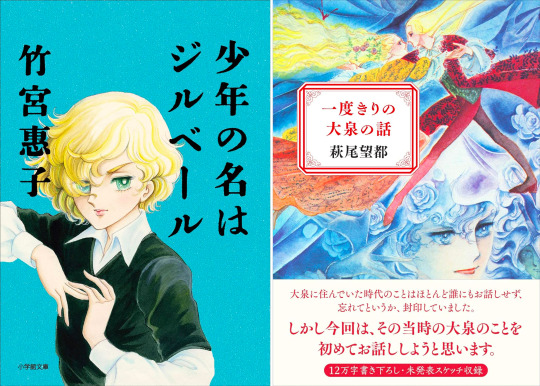
Keiko Takemiya and Moto Hagio, estranged since the late '70s, revealed details of their feud in autobiographic books: Takemiya's "Shonen no na wa Gilbert" (2019) and Hagio's "Ichidou kiri no Oizumi no Hanashi" (2021). The dispute, stemming from Takemiya accusing Hagio of plagiarism, was fueled by Takemiya's jealousy during a challenging creative and personal period. While Takemiya appears self-aware and analytical in her account, Hagio's book indicates she hasn't forgiven Keiko, revealing unresolved feelings. The publications triggered intense online debates.
Masuyama came from a sophisticated family that was very involved in arts and, from a young age, got familiarized with the world of music, literature, and movies. Her refined taste impressed Hagio and Takemiya. At a time when Japanese girls dreamed of Europe, Masuyama actually had friends living there and was up-to-date on the latest European trends. She also had a lot of knowledge of European cinema and literature.
As their rented house was old and rusty, Hagio and Takemiya started spending a lot of time at Masuayama's house across the street. She introduced them to films, songs, books, and paintings. It was Masuyama's taste -- including her interest in movies and books depicting gay romance and her desire for girls' comics to have bolder and riskier themes -- that helped to instill a passion in both artists to go further than the safe cliches usually depicted in shoujo works.
In 1970, editor Yamamoto convinced Takemiya to sign an exclusive contract with Shogakukan. The following year, Hagio also started publishing for Sho-comi and Betsucomi. Their work would attract a loyal fanbase, and aspiring manga-ka would flood their mailboxes. So Takemiya made a decision: to select female artists around her and Hagio's age to mentor and train at their shared home. Thus, the Oizumi Salon was born.
Despite attracting attention, Takemiya and Hagio's works were not always popular. In fact, they'd often rank last in readers' popularity polls, which tend to be all-deciding in manga magazines. But they persevered, and Yamamoto trusted them.

Keiko Takemiya aimed to establish herself with a top-rated series through "Pharaoh no Haka" (left) in order to garner the necessary respect from editors to write the series she wanted, "Kaze to ki no uta" (right). Despite her resolute efforts, "Pharaoh no Haka" never secured the top spot in Sho-comi's readers' poll, peaking at #2. Nevertheless, the series succeeded in elevating her fame and earning her the respect she sought.
In 1972, Hagio had an idea for a serial focused on a male European vampire. However, as she wasn't a famous artist, Yamamoto only allowed her to publish one-shots. So she came up with a plan: to write three interconnected standalone stories. To circumvent another restraint - shoujo editors' avoidance of male leads - she put the first story focus on Marybelle, Edgar's sister. Once Yamamoto realized what Hagio was doing, he was amused and allowed her to continue. And so, "The Poe Clan" series began. In 1974, Shogakukan finally started publishing their shoujo titles in compiled paperback format. In another proof of trust, Yamamoto chose Hagio's "The Poe Clan" as the first title of the Flower Comics imprint.
To everybody's surprise, "The Poe's Clan," in paperback format, was a groundbreaking success, almost instantaneously selling out its initial printing. At the time, Hagio had just started a new serialization, "The Heart of Thomas," a tragic gay love story set in an all-boys German school. As usual for her, the story wasn't all that popular with Sho-Comi's readership, and its lackluster results in the reader's poll almost got the series discontinued. But the notable success of "The Poe's Clan" tankobon assured editors, who allowed Hagio to continue the series. "The Heart of Thomas" went on to become another best-seller and a seminal shoujo title. It also attracted critical acclaim and a loyal fanbase to Moto Hagio, which in turn helped put the Year 24 artists -- who were pretty good at self-promotion -- in the spotlight.
Hagio, Takemiya, and several other "Year 24" authors drifted between being popular and underground. They had a sizable, loyal fanbase that followed them and turned several of their works into best-sellers. On the other hand, by finding a way around the usual shoujo traditions, they weren't particularly popular with the average shoujo reader, ordinary young girls across the country.
Their peculiar position forced them to be clever, so they could fulfill their creative desires as well as their editors' expectations, who were there to make sure the stories published were satisfying to the core readership. Takemiya wrote "Pharaoh no Haka," an Egypt-set romantic adventure, to be well-accepted so that she could then dedicate herself to doing what she truly wanted in "Kaze to Ki no Uta," a gay love story set in a 19th Century French boarding school.
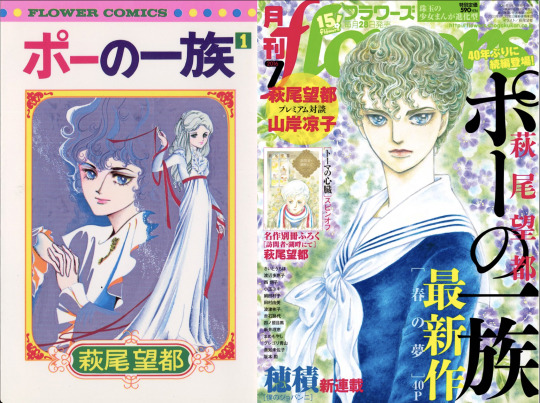
Initially overlooked in popular shoujo magazines, Moto Hagio gained success with "The Poe Clan" in compiled format, launching Shogakukan's Flower Comics imprint. Over time, she became a highly respected manga artist, the only manga-ka alongside legendary filmmaker Hayao Miyazaki to receive a Person of Cultural Merit recognition. In 2016, marking 40 years of the conclusion of her first hit, she released a new "The Poe Clan" chapter in Flower magazine, selling out the increased print run of 50,000 copies in a day. This success marked a significant shift for Hagio, who, despite not being a major magazine seller in earlier years, became a valuable asset to the struggling publishing industry. Following the one-shot, she released three more chapters and, in 2022, began a new sequel series.
Besides Takemiya and Hagio, several other notable shoujo artists who went on to become huge names used to frequent the Oizumi Salon and were part of the "Year 24 group." In the early '70s, most published their work on Shogakukan's titles, which had a "free policy" on storytelling compared to Margaret, Shoujo Friend, Nakayoshi, and Ribon. Then, as Shogakukan started being more strict to properly compete with the market leaders, several moved to newly launched Hakusensha titles Hana to Yume and LaLa. Influential names that were part of the movement included Yumiko Oshima, Yasuko Aoike, and Ryoko Yamagashi, among several others.
Despite their unorthodox preferences, they weren't necessarily trying to rebel against the system, they simply wanted to put out good quality work they believed in. Like other Japanese girls from that era, they were fascinated by Europe, and plenty of their stories took place on the continent. In 1972, Hagio, Takemiya, Yamagishi, and Masuyama made a 45-day trip to Europe, visiting the Soviet Republic, France, and several other countries, which had a profound impact on them. Still, their narratives were widely innovative. They often had male leads, introduced sci-fi, "boys' love," and other bolder genres to shoujo manga, and contributed to the evolution of shoujo illustration. Above all, this group of artists was the one who made clear to naysayers, once and for all, that shoujo manga is indeed an art form.
But while their influence in manga history is undisputed, other significant -- and much more commercial -- manga movements also shook the shoujo manga world during that decade.
A Need for Drama
When talking about '70s shoujo manga, it's common for minds to drift directly to iconic series from that time, like "Candy Candy" and "Rose of Versailles." But, unlike in present times, in that decade, the manga industry's focus wasn't on successful, long-running series but on the artists themselves.
As opposed to the struggling publishing marketing of today, major shoujo manga magazines all sold over 1 million copies during that decade. Manga in tankobon (standalone paperback) format was turning into a money-maker field, but being able to sell paperback was very much secondary compared to being a name capable of selling magazines. Keiko Takemiya and Moto Hagio, from the Amazing Year 24 Group, would go on to become household names and had best-selling series, but, at the time, they couldn't compete with the actual shoujo manga superstars who were the signboard artists of the Kodansha and Shueisha's shoujo titles, the ones who actually moved publications. These artists' work was the most significant indicator of what the mainstream readers wanted and aspired to back then.
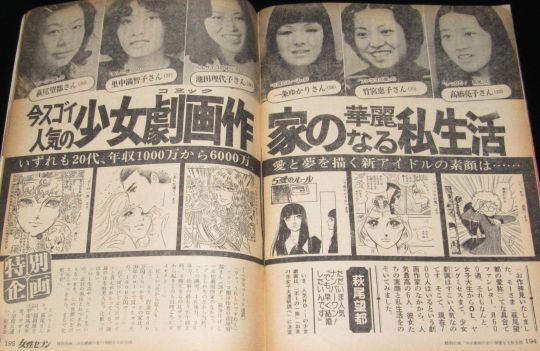
In a December/1975 issue, weekly Josei Seven spotlights the new generation of superstar shoujo manga artists: (l-to-r) Moto Hagio, Machiko Satonaka, Ryoko Ikeda, Yukari Ichijo, Keiko Takemiya, and Ryoko Takahashi. While contemporary manga-kas are highly discreet about their lives and do not even tend to show their faces, in the '70s, they were treated like superstars, and, in the article, the manga-kas openly discuss their love life and details of their high incomes, including how much they had in the bank and how much they spent on rent and daily utilities.
For Kodansha, the top shoujo artist was definitely Machiko Satonaka, who won the Best New Artist competition in 1964, when she was still a freshman in high school. There have been several high-schoolers making their debut in the industry throughout the decades, but, as the first, Satonaka caused a media frenzy. Her ascent gave confidence to countless other young women -- from "Glass Mask"'s Suzue Michi to Keiko Takemiya (who also won a smaller prize in the same competition) -- to pursue their manga careers.
The attention surrounding Satonaka, who went on to become a public personality with TV hosting gigs and other appearances, is another interesting, nostalgic phenomenon. In the past, it was common for manga superstars to have a strong media presence. Nowadays, the norm is the complete opposite: for manga-kas to be highly private, no matter how famous their work is.
In any case, Satonaka quickly proved herself to be more than a sensational news story as she created extremely popular mangas for Kodansha shoujo titles like Shoujo Friend and Nakayoshi. Her style, widely accepted by readers, became symbolical of the story-telling the '70s girls craved: extremely dramatic with emotionally driven plots and lots of bombastic twists and developments.
In his book on subcultures and otaku culture, sociologist Shinji Miyadai notes that '70s shoujo manga can be divided into very few categories. There is the category the Year 24 artists dominated -- which he defines as the "Moto Hagio domain" -- of works with a lot of artistic value, up-to-par with literature. And then there's the far more commercially viable "Satonaka domain," which represented the mainstream taste.
In the "Satonaka category," the artist depicts a stormy life story as a proxy experience for the readers. Of course, there are universal elements of love, friendship, and insecurity that girls can directly relate to. Still, these stories provide adventures that readers could never experience in the real world.
These facets of the "Satonaka domain" are present in almost all the best-selling, mainstream shoujo series of the '70s, like the revolutionary historical romance of "The Rose of Versailles," the dramatic rags-to-riches story of the beautiful orphan in "Candy Candy," and the rise of an ordinary girl to the top of the sports elite in "Ace wo Nerae." In all of these titles, you'll also spot other defining characteristics of '70s shoujo: the death of beloved characters and beloved female characters with voluminous blonde hairs and huge, sparkling eyes (a legacy of Macoto Takahashi, the illustrator who, throughout the '50s, created the art that directly influenced subsequent shoujo history).
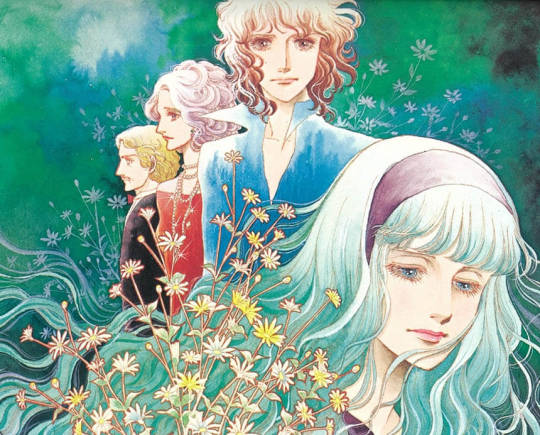
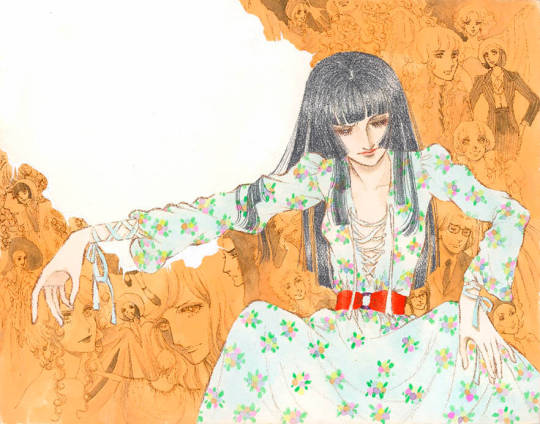
Yukari Ichijo was the most prominent Ribon signboard artist throughout the '70s, creating popular mangas like "Suna no Shiro" (left) and "Designer (right). Young girls across the country adored her work despite the adult drama in it.
Since these stories are extraordinary and dream-like, many of them use Europe or the US as their setting, another reflection of the times when Japanese youth dreamed with the West.
While Satonaka was Kodansha's star, Shueisha also had its top shoujo artists. For Margaret, it was Ryoko Ikeda who kept creating memorable dramatic manga after the conclusion of "The Rose of Versailles." Other classic '70s dramatic works published in the weekly included Kyoko Ariyoshi's ballet drama "Swan." Meanwhile, over at Ribon, no one shone brighter than Yukari Ichijo. Ichijo's works, which young girls across Japan devoured, contained a lot of adult drama with adult characters. Her 1974 manga, "Love Game," had a bed scene. One of her most celebrated works of the decade, "Suna no Shiro" (Sand Castle), dealt with incest. While Ichijo is the one who stood the test of time, another artist who also enjoyed great popularity in Ribon following this formula was Kei Nogami.
These mangas served as an escape for girls, who left their ordinary school life behind for a few hours to embark on extraordinary adventures. In contrast, one of the main genres in contemporary shoujo is unassuming, everyday high school romance. How could the shoujo segment go through such a drastic transformation? The reasons for that also dates back to the 1970s.
Part 3
#shoujo manga#vintage shoujo#otometique#yumiko oshima#keiko takemiya#yumiko tabuchi#hideko tachikake#machiko satonaka#yukari ichijo#ribon#1970s japan#1970s#year 24 group#moto hagio#vintage manga
38 notes
·
View notes
Text
Did Mikasa (re)marry?
Exactly three years ago, i wrote a post with the title "Mikasa will kill Eren". I haven't written a lot about AoT since then. I still keep AoT in my heart and i read news and posts about it daily. Although i do not participate that much in discussions about it, i still read what other people have to say. This is about to change. Yes, i know that the anime ended 3 months ago and i know that AoT's time in the spotlight is probably gone for good, with very few events ahead of us. In time, people will move on to other works. That is the cycle of life for fans of stories of any medium. And yet, now, more than ever, i want to start writing about AoT and my favorite characters (Mikasa, Eren etc) again. I will begin by offering my view on whether or not Mikasa married or, more accurately in my opinion, remarried after Eren's unfortunate end.
Why remarry?
Why do i use the term remarry? After all, Mikasa and Eren were never officially married. There was no ceremony, no rings, no nothing. If anything, in the physical world, the last time Mikasa and Eren spoke was when Eren told her he hated her. That is indeed true. However, Mikasa and Eren spent quite some time in the paths together (be it months, years, or a few minutes). The realm of the paths is (was) not a dream place. It wasn't something fictional. It was reality, just like Armin described it in chapter 136. It is a different dimension where time goes by very differently compared to the physical world.

Eren brought all of his friends in there to speak to them and reveal his true intentions. With Armin, he also went on a journey, visiting all the places they wanted to see. With Mikasa, after talking to her about his plan, they decided to forget it all and spend their time together. They replayed the "What am i to you" scene from chapter 123 and Mikasa chose to express her true feelings to him, while also telling him to run away together. Eren then grabbed her arm and they escaped to the mountain cabin. From the way they act towards each other, it is easy to tell that they viewed themselves as husband and wife. This is also showcased by what Mikasa wrote in Eren's tombstone. The last word is "あなた", which typically means "you" in japanese, but, when used by a spouse to her husband, it means "sweetheart, dear etc". So, it is obvious that for Mikasa, Eren was her husband and the same holds true for Eren. This means that if Mikasa were to marry, it would be her second marriage, or, at the very least, this is how it would seem to her. For all intents and purposes, Eren and Mikasa were husband and wife in the Paths and after his death, Mikasa is presented as a widow.
The extra pages and the songs
Anyone who was reading the manga during its run knows that the original ending, the one shown in the Bessatsu Shonen Magazine, had Mikasa thanking Eren for wrapping the scarf around her while the bird was flying away. The bonus pages expanded the original ending and showed Mikasa visiting Eren's grave again and again, once with a man and a newborn child, still young, and once accompanied by two couples and their young children, while old. The difference between the two is also reflected in the episodic format of the anime ending, where the bonus pages do not appear and the closing song is different. Instead of "二千年… 若しくは… 二万年後の君へ・・・", which played in the special version, the episodic format uses "いってらっしゃい".
The episodic format provides an emotional closure for the relationship between Eren and Mikasa. The lyrics of the song reveal that Mikasa wants to and believes that she will meet Eren again. The original animation of the ED song implies that Eren and Mikasa do meet again in the afterlife after Mikasa's death. They are now free to be with each other for eternity.

The special format represents the theme of "life goes on". Wars never end permanently. They are just interrupted by long periods of peace. The same applies to Mikasas' life. In the anime, Eren's grave is visited by all of his friends, exactly 3 years after his death. Exactly 11 years after his death (7 winters and 8 springs after his friends visit his grave, slow it down as much as possible and count the season changes), Mikasa visits his grave with a man and a child. This scene has 2 very popular interpretations. One is that Mikasa married someone (Jean) and had a child with him and the other one says that Mikasa remained single and virgin forever and that the kid is adopted and that the man is Armin.
Let's start with the second option. The major arguments are that (in the manga) Mikasa still covers her Hizuru tattoo with the bandages and that she she offers roses to Eren's grave and that the number of the roses signify that she never found someone else. Some people also argue that Mikasa loving someone else romantically goes against her character.
I do not agree with this interpretation. Covering her tattoo does not mean that she didn't pass it down to her children and even if she didn't pass it down, it doesn't mean she didn't have kids. Also, in the anime, the flowers she offers are not roses. I would agree that it would be out of character for Mikasa to find someone else, but only as long as Eren was alive. It would probably take her a very long time, but if the right man appeared, maybe she could fall in love again.

During Eren's crying tantrum about Mikasa to Armin, he mentioned that if she were to find someone else it should take her 10 years at least. The anime went out of its way to show Mikasa appearing with her new family, a man and a newborn kid exactly 11 years after his death. This points towards Mikasa remarrying. The anime also added a ring to her left ring finger during her funeral scene. The lyrics that play during Mikasa's visits to Eren's grave with her new family are these "時が運んだ 穏やかな日々 手向けた花のように秘めた言葉は 誰にも告げず逝く". This means that the time brought gentle days to Mikasa and she kept her feelings for Eren to her heart, with the flowers and the words on the tombstone revealing their true extent. In my opinion this showcases that Mikasa spent peaceful days with her new family, but she kept her feelings to Eren deep in her heart, as shown by her constant offering of flowers to his grave and the words she wrote in the gravestone.
For me the biggest indication that Mikasa did remarry is the fact that these scenes exist in the first place, both in the manga and in the anime. Isayama felt the need to show these images, when the Magazine ending was very open to interpretation. There would be no point to adding these scenes, only to make the ending more ambiguous. The bonus pages are there to clarify what happens to Mikasa's life and the island in the long years after Eren's death, not to muddy the waters. If Isayama wanted the ending to be completely open to interpretation, then there would be no reason for the new pages.
Why Jean?
Shipping wars are part of most fandoms and the AoT fandom is no exception. During its run, the biggest rivalry was the one between the EM and EH supporters. Now it is between EM and JK fans. EH was never a thing in the story, but the relationship between Eren and Mikasa was the most important in the story. The entirety of Attack on Titan is built based on the relationship between its male and female leads. They are the backbone of the story and without them there would be no AoT. Of course, a tragic conclusion for them hurts people. Especially when Mikasa eventually gets married to someone that, during the duration of the plot, she didn't show any interest. But, this is not really relevant. The moment Eren died, the plot pretty much ended. The plot does not follow Mikasa's healing process and family life, because it doesn't affect anything. Also, it is so far into the future that the characters involved are practically different people. Maybe in the future Isayama will show this development in a short story, like he will do with Levi in vol. 35, but, for now, this is just an additional detail that is only 3 panels long.
Even without mentioning the physical aspects of the man shown next to Mikasa, Jean, throughout the story has been presented as the "Eren-lite". He is second best to Eren and he compares himself to his "rival". He is jealous of how much Mikasa cares about Eren, he places directly under him in training, he views him as more courageous, strong and cool than him. On the other hand, Jean is presented as a mentally stable person, while Eren is not. Jean of course can never be as passionate as Eren and he can't match Eren's kindness when Eren is kind, but he could also never be as cruel as Eren. He disguises as Eren throughout the story and he is presents himself as the best successor for Eren's titan. Most importantly, Jean shares a special connection with Eren, he understands him and he loves him.

So, it is no suprise that Isayama would have him end up with Mikasa after Eren's death. There really is no one better for Mikasa. Jean is the best option if she can't be with Eren. He cared for her throughout the series, protected her once and he even tried to paint Eren in a better light after the latter offended Mikasa. He is also the only one who can understand her love for Eren and still be with her without getting jealous over the fact that she would never be able to love him as much as she loved Eren. This is something that even Jean's voice actor expressed in the recent Attack on Titan festival that celebrated the 10 years since the beginning of the anime. He felt that Jean got to be with Mikasa and he was comforting her, but he knew that he could never replace Eren in her heart. Yui Ishikawa, Mikasa's voice actress, also said that for Mikasa, no matter how many years pass and how many things she experiences throughout her long lifespan, Eren will always be the number 1 in her heart.
Does that diminish her love for Jean? Does that mean that she never truly loved Eren? No. It simply means that Mikasa fell in love again, 10 years after Eren's death, with a man who is as close to Eren as possible. Jean most likely won her over. She didn't marry him out of some desparate need to be with a man, but because she found the strength in her heart to love someone again, even if it wasn't to the same extent as before. That doesn't make her dirty or impure, like some fans want to believe. This obsession with virginity is frankly stupid. First of all, Mikasa, by the time the she remarries, is, probably not a virgin. Unless she only spent a few minutes with Eren in the world of the paths, the two of them probably did more things than just talking and fishing. Even if she were, virginity is nothing special. Mikasa marrying someone else and having kids with him does not mean Eren got cucked. It doesn't mean that Jean won against Eren Mikasa still loving Eren does not mean that Jean got cucked by a dead man, nor does it mean that he got damaged goods. These points of view are ridiculous and are only expressed by very immature individuals and/or incels. Jean is probably somewhat sad that Mikasa and Eren didn't get to live the life they wanted together and he is probably thankful to Eren for giving him the chance to live his dream life. Jean is not the type to gloat or ridicule his dead comrade, nor the type of guy to be bitter, because Mikasa loved Eren so much.
Mikasa moved forward with her life (not moved on, widows hate this term, because it is closer to forgetting your previous spouse), without ever forgetting her big love or changing her feelings for him. And in the end, after spending many decades with her new family, she passed away peacefully and reunited with her most beloved person in the world in the afterlife. For some, Mikasa reuniting with Eren in the afterlife means that she didn't remarry, because her husband should be her soulmate and if she is with Eren she didn't have a second husband. I disagree here as well. There is no information about how the afterlife works and making assumptions about it based on real world theology is dumb. People can love more than once. If your last spouse is your soulmate, then what happens to people like Grisha? The only thing we can do is go by what is shown and what is shown is that Mikasa both remarried and met Eren in the afterlife.
The same goes for those who believe that Mikasa should not meet Eren in the afterlife, because Eren is a criminal. Attack on Titan does not pass judgement to the actions of its characters that much. Of course, Eren's actions are horrific, but the entirety of the cast and the narrative tries to shift the blame to many more people than just Eren. Eren is not the only one responsible for how things turned out. All the characters sinned. Not to mention, Mikasa expressed her certainty that she would meet Eren again in the end in the final ED song and this is what is shown. Furthermore, after Mikasa's death, the lyrics that play are these "レクイエムレクイエム檜には君た花を
罪を散すなら 暁よ照らせ". This means that if sins are to be forgiven, then dawn will illuminate the flowers under the cypress. Eren's sins by the time Mikasa died have, probably, been forgiven. In any case, repeating my previous words, we can only go by what is shown and what is shown is that the two of them do reunite in the end.
What is the point of the debate?
The debate is probably meaningless. Whether or not Mikasa married does not affect the story in any way. It simply concludes Mikasa's story. Of course, this means that i wrote close to 3 thousand words for nothing, LOL. Nonetheless, i find it ridiculous that large amounts people still debate about the frankly obvious context of 1 panel. This toxic debate should have stopped long ago. What matters is that Mikasa got to live a long and happy life with a person who loved and respected her, just like Eren ultimately wanted and she then reunited with her most beloved. Sure, it hurts that we couldn't see more of Eren and Mikasa as a couple, after being introduced to them from the very first page of the story, but this is no reason to slander other parts of the fandom or the voice actors who did their best to portray these characters for over a decade. Mikasa was lucky enough to be loved so much by two men. She got to spend her time on Earth with one of them and infnity with the other. Despite all of her shortcomings and the bad luck she faced in her life, Mikasa rose stronger from each challenge and earned her happily ever after. This is what's important. In the future, we might get to see more of her family life with Jean and the time she spent with Eren in the paths and her next meeting with him.
#eremika#aot meta#aot theory#eren yeager#mikasa#jean kirstein#jeankasa#armin arlert#attack on titan final chapter#attack on titan final season#shingeki no kyojin analysis#shingeki no kyojin#snk meta#aot#snk#attack on titan#mikasa ackerman#attack fes#yui ishikawa#kisho taniyama
31 notes
·
View notes
Text
Bessatsu Shonen Magazine Q&A ~ jump from "in her head" to "in her dreams" or be careful what you wish for 😏
chapter 56

chapter 127

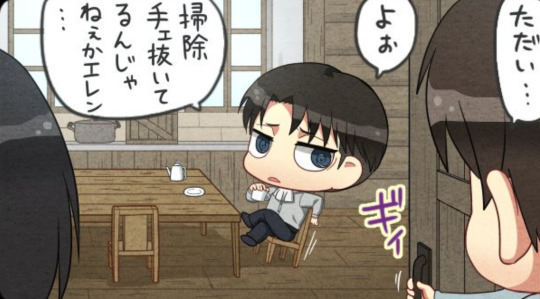
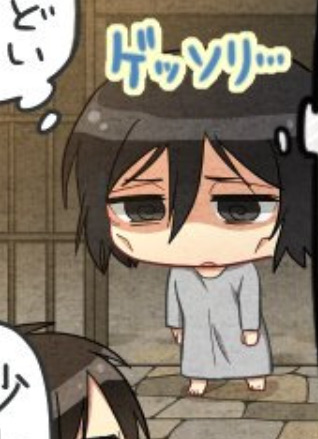
#lol#snk#snk meme#aot#aot meme#mikasa#levi#mikasa ackerman#levi ackerman#bessatsu shonen#bessatsu shonen magazine#bessatsu shonen magazine q&a#rivamika#snk shitpost#aot shitpost#snk caps#aot caps#snk official art#aot official art
32 notes
·
View notes
Text
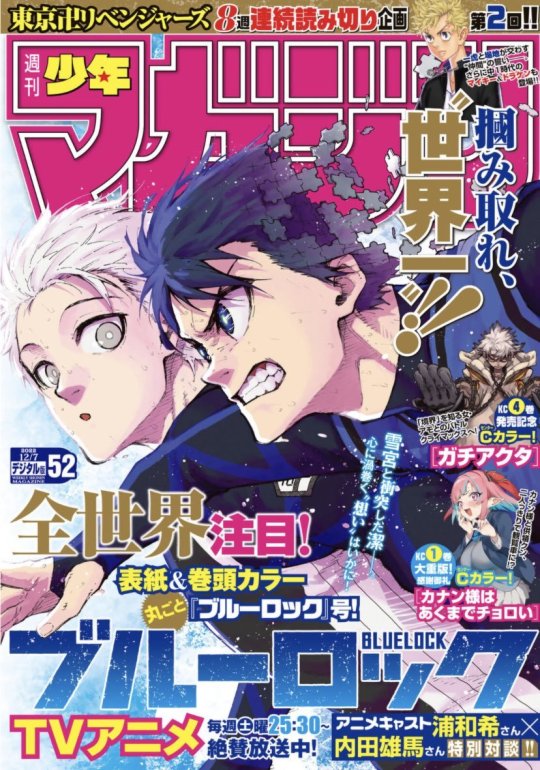
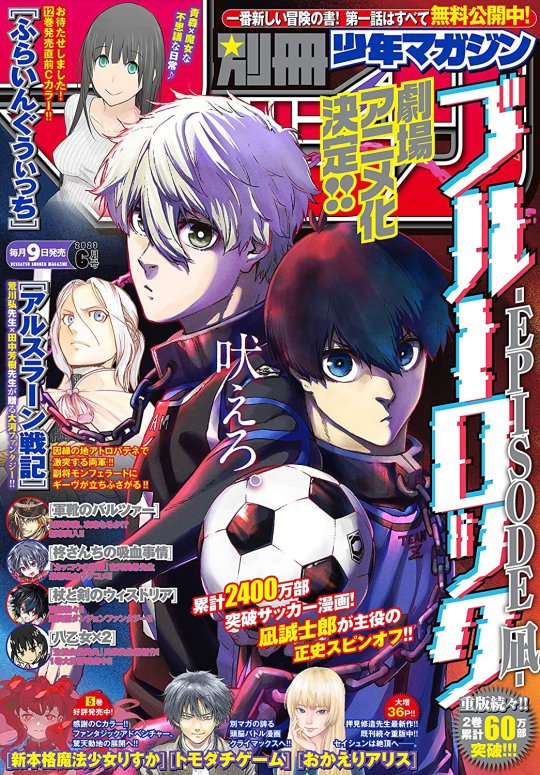
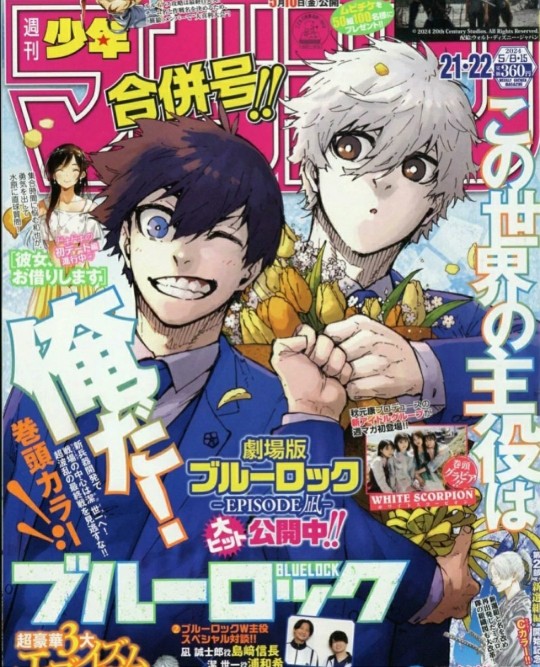
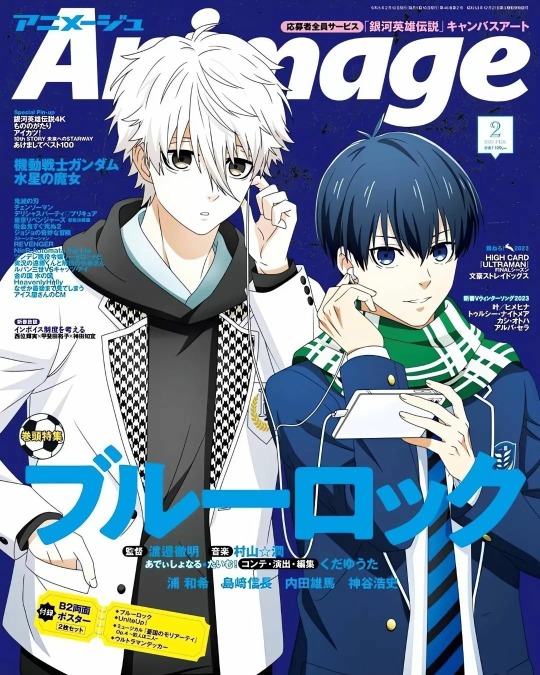
Nagisagi covers 🖤💚
#blue lock#isagi yoichi#nagi seishiro#weekly shonen magazine#bessatsu shonen magazine#animage#I love them both so much 🥰
41 notes
·
View notes
Text
The Yaoi Ronso and Akiko Mizoguchi
here the original post this one stems from. I advice reading that one first if you haven't. Please note I am no expert on this, and this is a post to give an overview of the different topics treated. There might be some inaccuracies.
The Yaoi Debates - 1992
In 1992, a “confrontation between women yaoi fans and gay men about the relation between the representation of homosexual love and society’s prejudice against gay men in real life” that happened in the japanese feminist magazine Bessatsu CHOISIR.
The Yaoi Ronso (or Yaoi Debates) were a series of letters published in the magazine between Masaki Sato (a gay activist), who criticized the genre, and the female readers, who defended it. Masaki Sato criticized yaoi for showing examples of homosexual life that could negatively impact young gay men who read them. Meanwhile female readers argued back that shonen ai/yaoi was not meant to depict reality, or real men. This exchange of letters ended with Masaki Sato and some of the female readers agreeing in some points, and Sato suggesting that instead of escaping from reality these stories should make reality easier to live in.
Up to that point, in most of the 20 years of academic studies regarding the subject, it has been argued that the men depicted in these stories chould be thought as a third gender free of societal expectations, object of love in a pure form. A means for female sexual liberation and exploration, made possible thanks to its detachement to reality. Lots of theories at the time said that women used these “boys” to avoid having to become “women”, and the expectations that came with the title. Maintaing the “boyhood” from childhood that is lost as they become women.
After the Debates, female academics started evaluating the power of the symbol of male homosexual love fantasies. And so started a discussion about the difference between reality and fantasy, getting to question topics such as depictions of rape being easily allowed. All of this as part of gender studies and manga studies.
One of the more discussed things in academic studies regarding shoujo and BL is its heterosexual female public. The shonen-ai/yaoi/BL has served as a medium for homosexuals to find each other but also for heterosexual women to flee society’s heteronormative and gender pressures, heavily associated with fantasy. One example of this is the magazine Barazoku (meaning Rose tribe, bara is a term highly associated with gay content). Which featured a column where letters of female readers would be published. At first these letters expressed the desires of these women to marry gay men, or become gay men themselves to enjoy a freedom they believed gay men enjoyed (they would usually be referred to as okoge or fag hags). Despite its problematic nature, the chief editor of the magazine went against advice and requests to stop publishing such letters. From there on started to appear letters from lesbian women (which ended up being the only kind of letters that woul d be featured) who, interested in depictions of homosexual love would realize their own desire for the same sex. This column was then changed to the name Yurizoku (the Lily Tribe, yuri is a term highly associated with lesbian content).
The 1990s were also when there was a “gay boom” in japan (lgbt movie festivals and other things started happening). Many of the manga magazines that published BL would feature articles that introduced the japanese gay lifestyle to its women readers. Like, gay bars, Shinjuku Ni-Choume (the gay district of Tokyo), or art popular among gays or even foreign gay communities. Gay men and women has been learned from each other in this way for a number of years now.
Academics noticed the impact of the Yaoi Ronso on BL as they started to observe gay characters who reached a happy ending emerging. The Yaoi Ronso had a definite impact on the evolution of the gerne as it started to take into account that (having meant to or not) they had a power of influence that affected real people.
sources Kayo Takeuchi James Welker Wim Lunsing
However, Wim Lunsing brings an important point to the table:
“Gay manga are not essentially different from BLB manga.”
It is true that BL is the most popular form in which we find gay stories in Japan. However, gay comics had existed for almost the same amount of time as yaoi.
Short introduction to Male Love (ML)
ML, Gei Komi and Bara are the terms with which gay content made by and for gay men are refered to. Gengoroh Tagame is one of the most prominent figures of it. Before he started publishing his very sexual BDSM comics, the beauty ideal that was pursued was the bishonen aesthetic. However, Tagame’s characters where big, muscle-y, fat, hairy men, with a clear influence by Tom of Finland, and its popularity changed the tastes of japanese gay men.
Gengoroh Tagame also started writing slice of life manga in an effort to educate japanese society about gay life and LGBT issues. He is the author of the manga My Brother’s Husband (which was later turned into a 4 episode series).
Another notable manga is Until I Met my Husband, based on an autobiographic essay by Ryousuke Nanansaki.
Akiko Mizoguchi, the Rape Fantasy Expert - An Extra
Akiko Mizoguchi is a notable researcher of BL studies. She is the expert in regards to the analysis of depictions of rape, however she writes mostly in japanese, and my comprehesion of it is very limited for academic readings.
She has wrote an extensive book: Theorizing BL As a Transformative Genre: Male-Male Fictions by and for Women - which is currently being translated to english.
Summary:
Identifying Mari Mori's 1961 short novel as the origin of the genre and the 1970's-1980's "Beautiful Boy" manga within the girls' (shojo) manga as the precursor, Dr. Akiko Mizoguchi discusses how the commercial BL genre has transformed into an unprecedented genre with feminist and queer activist potential. Recent commercial BL genre has produced stories that portray strong female characters and gay-identified characters who come out and engage in other realistic negotations. Mizoguchi argues that while BL represents beautiful male characters at the center, for veteran women fans and authors, it functions as a female sexualized discursive space in which they exchange pleasure to the extent that these women can be called "virtual gay men" and "virtual lesbians."
source
Mizoguchi is a lesbian woman trying to bring a new type of analysis of BL taking lesbianism into account.
Other academic authors with a lot on yaoi manga/BL are Mark McLelland and Thomas Baudinette.
Conclusion (of sorts)
Even though The Yaoi Debates ended, it is still being had up to these days. Both in academics and within the BL fandom. If we change the exhange of letters in magazines for the internet, we find ourselves in a similar situation. I hope that through this post the Debates have become clearer and easier to understand for those who didn’t know about it.
I close with this quote from one of the text I read for this post:
“The implication that gay sex is objectified for the purpose of the sexual liberation of women surely is a queer use of male homosexuality par excellence.”
Together with a longer version of the previous quote:
“It rather seems that gay men like Satō have difficulty with the idea that women may look at them as sex objects. Gay manga are not essentially different from BLB manga.”
Make with it what you will, but it is indeed food for thought.
Closing Remarks
For those curious ones, wanting to look into how the gay community of Japan was in the 70′s, check out Funeral Parade of Roses. And if anyone is interested in male prostitution in Japan, check out Boys for Sale (if you can, if not here’s an interview).
If you’ve made it to this point, I hope you found this post interesting or helpful in whichever way it may be needed. I have mainly summarized what little I know on the topic but if anybody is curious about the big details in an academic way, here is the best article on it I have been able to find: The Yaoi Ronso (by Wim Lunsing).
Edit: this post has been updated to correct some mistakes. If you happen to see any more please do point them out
#the yaoi debates#yaoi ronso#bl fandom#bl history#bara history#I am not at all an expert on the subject but I do think it is an interesting topic#I'm looking forward to what everyone will think of this#I hope it makes for fun conversation
69 notes
·
View notes
Photo
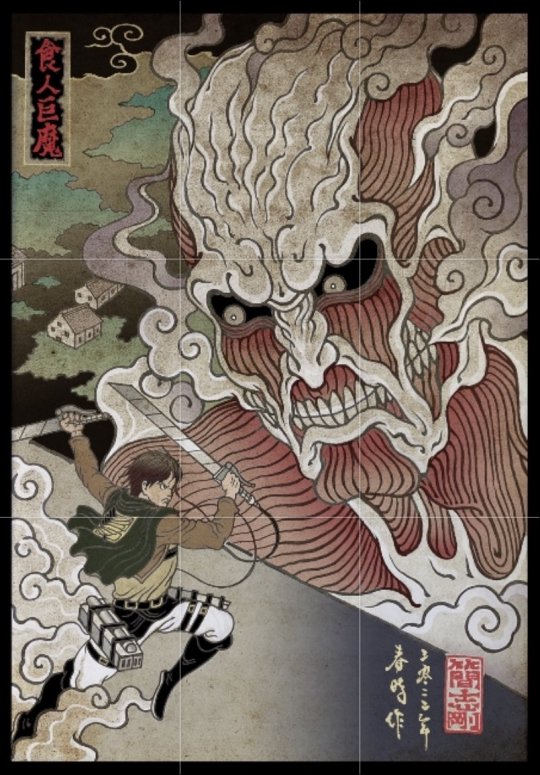
art by Justin96636
13 notes
·
View notes
Note
Hi! I've come back to the fandom after a very long time and I had a question for you (I know you get a lot of asks, so I'm sorry if someone has asked this same thing before!)
I've been reading a lot of Eruri doujinshi that seems to reference a lot of official "AUs" like the several different highschool ones & one where Levi is a salaryman(?I think???)
Do you have some kind of list of these official AUs? Or just the ones that often show up in fanwork? I feel a little lost ><;; (Thank you in advance!)
Hello Anon, welcome back to the fandom! I've never seen a comprehensive list of all the AUs that have featured in the myriad franchises that have appeared over the years, but here are some of the most popular, in no particular order.
School Castes / High School AU
This one is by Isayama himself and it appeared as a short serial alongside the manga in Bessatsu Shonen magazine. Erwin is a history teacher and Levi is the school janitor.
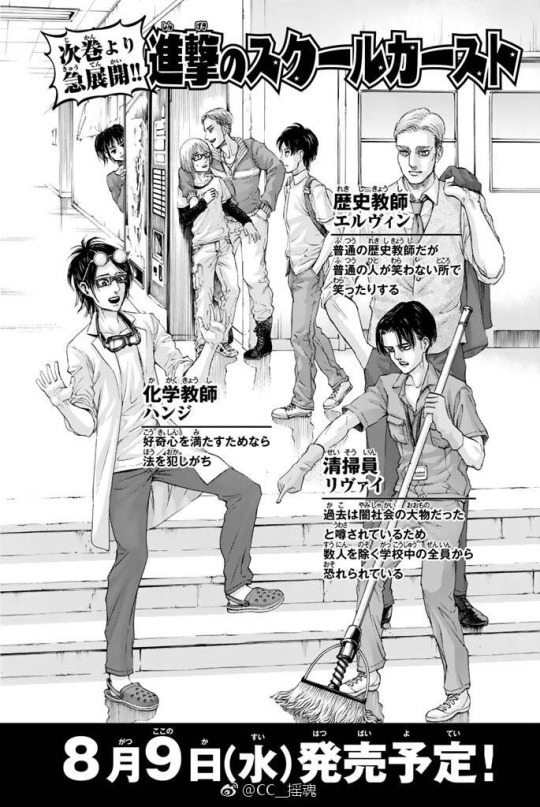
In one episode Eren, who is a pupil at the school, daydreams that the school teachers have turned into zombies. I've lost count of all the fics this one has inspired. @ladymacbethsspot's Love Bites is one of the best.

In a variation on this theme Nobiace recently released a collaboration where Erwin is a PE teacher and Levi is a science teacher. The fandom has come up with some "interesting" uses for Erwin's whistle...

Sukiya AU
This was a collaboration with the Sukiya Gyudon restaurant chain. The characters all came with their own little bios. Levi was a salaryman and Erwin the foreman of a construction site. Erwin was Levi's senpai when they were in college together and they often shared meals together in the restaurant. The Sukiya AU has inspired loads of fic and the fandom has universally agreed that Sukiya Erwin is the horniest Erwin. I wrote a Sukiya AU called Building on the Past.
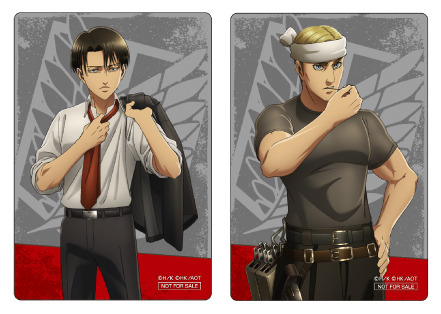
Mer / Royalty AU
This was a series of chibis that corresponded to the signs of the zodiac. Erwin was Leo and Levi Capricorn. These cute chibis inspired some incredibly angsty fic and art.

Neetwin
This is one of six “What If?” illustrations that Isayama did for the Shingeki no Kyojin Inside & Outside Guidebooks in 2014. Neetwin has inspired some hilarious art and fic over the years, including the absolutely priceless Gamerwin by @lustfulcat

Sanrio AU
An official collab with Sanrio where they made Erwin Hello Kitty and Levi Bad Badtz Maru.
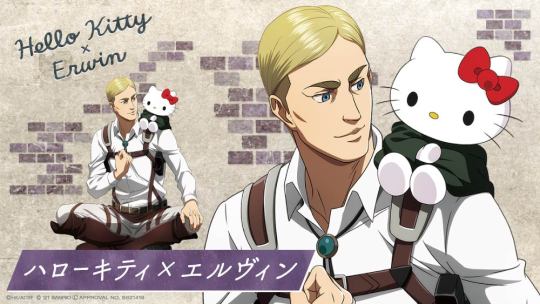

Silver Leggings Levi
This was a collaboration with Tokyo Girls back in 2017. It's not so well known now, but it was hugely popular at the time. I wrote a dumb fic about Levi's iconic silver leggings called Chrome.

Levi's First Snow
This gorgeous art appeared in one of the official SnK Calendars. So many writers and artist have created their own interpretation of this touching scene.

Cougar / Kitty AU
A recent collaboration with Re-Shazam which featured all the characters as different kinds of cats. Erwin is a cougar, I forget what breed Levi was supposed to be, but he's small, black and angry 😂 This one inspired an enormous amount of adorable art, and it's still going strong.

There are loads more but these are the ones that have been most popular and have inspired the most fic and art. Hope that helps to clear up the confusion Anon!
83 notes
·
View notes